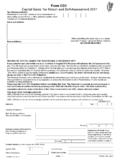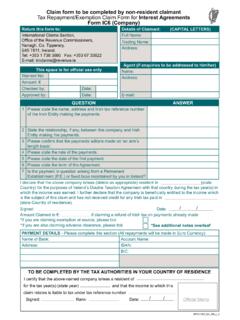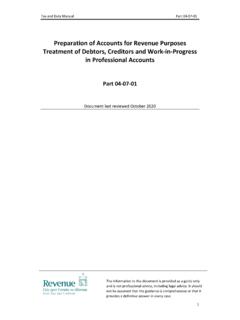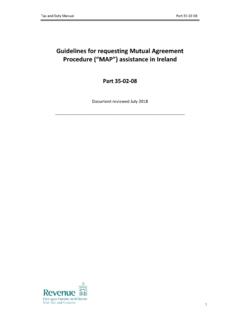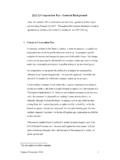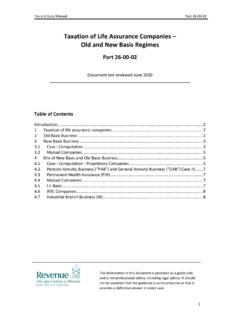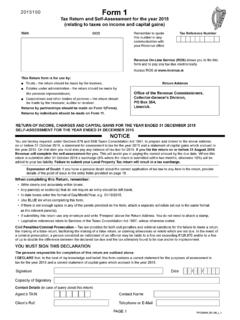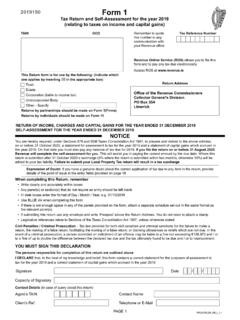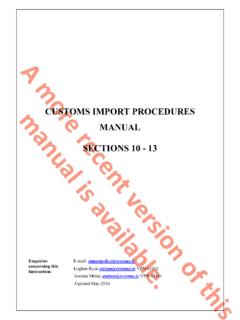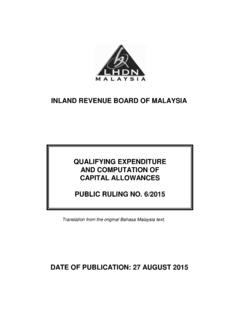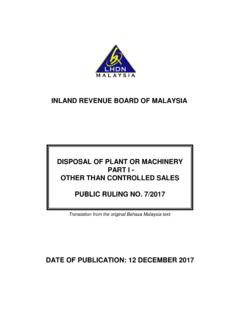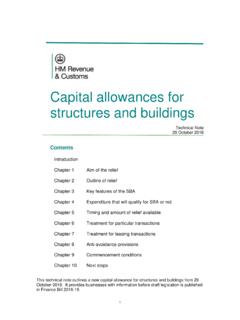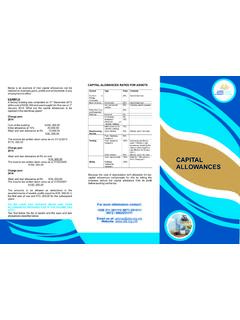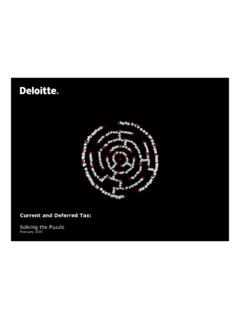Transcription of Part 09-02-05 - Tax Relief Scheme for Capital Expenditure on …
1 Tax and Duty ManualPart 09-02-05 The information in this document is provided as a guide only and is not professional advice, including legal advice. It should not be assumed that the guidance is comprehensive or that it provides a definitive answer in every allowances for intangible assetsPart 09-02-05 This document should be read in conjunction with section 291A of the Taxes Consolidation Act 1997 Document last updated March 2021 Tax and Duty ManualPart 09-02-052 Table of of Asked assets qualify for allowances?.. financial assets included?.. is goodwill treated?.. Revenue provide an advance opinion on whether a particular intangible asset is eligible for allowances?
2 Allowances available for Capital Expenditure on internally developed intangible assets as well as intangible assets which are acquired by a company?.. is the accounts-based allowance computed?.. a company opt for a fixed-rate allowance ?.. companies required to provide Revenue with the basis by which accounting depreciation and allowances are computed?.. a company incurs additional Capital Expenditure subsequent to acquiring an intangible asset, can this be taken into account?.. the acquisition cost of an intangible asset includes annual royalty payments ( based on sales) in addition to an upfront payment on acquisition, can an allowance be claimed under section 291A on the capitalised value of such payments as shown on the balance sheet?
3 A balancing charge or balancing allowance apply on the disposal of an intangible asset?.. allowances available where intangible assets are acquired as part of the acquisition of a trade or business?.. allowances available for Capital Expenditure on the acquisition of intangible assets from a connected person?.. section 400 applies to a company reconstruction, are allowances available to the successor under section 291A?.. does section 291A interact with the transfer pricing rules in Part 35A?.. with section 288(3C).. with section 291A(3).. information/documentation may be required to support the value attributed to an intangible asset?
4 Revenue consult with an expert in relation to the valuation of an intangible asset?.. a company have to be carrying on a trade to qualify?.. Revenue give an advance opinion on whether activities involving intangible assets qualify as trading?..17 Tax and Duty ManualPart Expenditure on intangible assets is incurred prior to the commencement of a trade, will that Expenditure qualify for Relief ?.. a company have to incur Capital Expenditure to qualify for allowances under the Scheme ? Will an acquisition of specified intangible assets involving the issue of shares by the acquiring company qualify for allowances?
5 There restrictions on the offset of Capital allowances against trading profits?.. ring-fenced against income from the relevant on forward of excess allowances and excess there a restriction on the deduction of interest on borrowings in respect of Expenditure on the provision of specified intangible assets?.. company s relevant activities relate to Expenditure on intangible assets before 11 October 2017 and Expenditure on intangible assets on or after 11 October does Expenditure qualifying for allowances under section 291A interact with section 766 TCA 1997?.. does section 291A interact with the 3-year tax Relief for new start-up companies?
6 23 Appendix 1: List of Specified Intangible Assets Included in and Duty ManualPart manual provides guidance on the operation of section 291A of the Taxes Consolidation Act 1997 ( TCA 1997 ), which makes provision for Capital allowances for Expenditure incurred by companies on intangible of schemeSection 291A TCA 1997 provides for Capital allowances against trading income for companies that incur Capital Expenditure on the provision of intangible assets for the purposes of a trade. The Scheme applies to a broad range of intangible assets ( patents, copyright, trademarks, know-how) which are recognised as such under generally accepted accounting practice1 and which are listed as specified intangible assets in section 291A(1).
7 An up-to-date list of specified intangible assets is provided at Appendix intangible assets are treated as machinery or plant for the purposes of allowances provided2 so that the normal rules regarding wear and tear allowances, balancing allowances and balancing charges for Capital Expenditure on machinery or plant also apply for Capital Expenditure on qualifying intangible assets, subject to the specific provisions of section available under section 291A are based on the amount charged to a company s Profit and Loss account or Income Statement for the accounting period in respect of the amortisation or impairment of the specified intangible asset.
8 However, companies can opt instead for a fixed write-down period of 15 years at an annual rate of 7% of qualifying Expenditure for 14 years and 2% in the final balancing charge or allowance (that is, an adjustment to the quantum of the allowances made) may arise in a chargeable period where, in relation to any machinery or plant in respect of which Capital allowances have been obtained, certain events, including the disposal of the plant or machinery , occur (section 288 TCA 1997).3 Section 288(3C) provides that a balancing charge is not made where Expenditure was incurred on the provision of a specified intangible asset before 14 October 2020 and such an event (including the disposal of the asset) occurs more than five years after the beginning of the accounting period in which the asset was first provided for the trade.
9 This is subject to the condition that the disposal may not result in a connected company claiming allowances under section 291A in excess of the tax written down value of the asset at the time of transfer ( the amount of allowances in respect of which Capital allowances have not been claimed) section 291A generally accepted accounting practice comes within the definition provided in section 4 TCA 1997 and includes accounts prepared in accordance with international accounting standards (IAS) and accounts prepared under Irish for the purposes of Chapters 2 and 4 of Part 9 TCA 19973 Guidance on the application of section 288 TCA 1997 is included in Revenue s Notes for Guidance, Taxes Consolidation Act, Part 9.
10 4 Where a disposal occurs before 23 October 2014, the non-application of a balancing charge is subject to the condition that the event may not result in a connected company claiming allowances under section 291A. Tax and Duty ManualPart 09-02-055A company must be trading to qualify for Capital allowances (although pre-trading Expenditure is eligible for allowances) and the specified intangible asset(s) on which Capital Expenditure is incurred must be used for the purposes of its trading activity. The Expenditure must be incurred for bona fide commercial reasons and not as part of any tax avoidance restrictions apply to ensure that the provision operates effectively.
